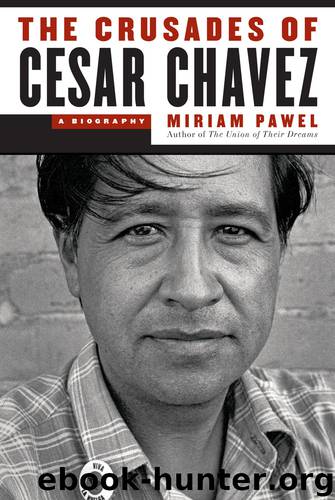The Crusades of Cesar Chavez by Miriam Pawel

Author:Miriam Pawel
Language: eng
Format: epub
Publisher: Bloomsbury Publishing
Published: 2014-01-29T16:00:00+00:00
Chapter 24
The Seeds Are Sown
We have demonstrated to the whole world our capacity for sacrifice. We have demonstrated for many years our willingness, our commitment, and our discipline for nonviolence, and even more important than that we have demonstrated to the whole world that nothing is going to stop us from getting our own union.
At the end of a marathon day presiding over the first constitutional convention of the United Farm Workers of America, Cesar Chavez paused to reflect on the historic occasion. After a celebratory evening of music and dancing, Chavez chatted in the early morning hours of September 22, 1973, with Jacques Levy. The union leader was pensive, expressing pleasure tinged with regret. On one hand, Chavez told Levy, the convention was a dream come true. Hundreds of farmworker delegates, debating resolutions, learning Robert’s Rules of Order, building their own union. The next day, delegates would elect the first executive board, and that milestone would usher in what Chavez called a “so-called democracy.” From now on, he said with resignation, his strongest colleagues would inevitably become his enemies.
Your best people always turn out to be the opposition, Chavez explained, because the strongest leaders have the most ambition. In this “so-called democracy,” he would be forced to get rid of potential challengers, otherwise they would get rid of him. He would have to eliminate those who showed the greatest promise, and inevitably be left with the second-rate. “I don’t like it,” Chavez said. “It makes me puke.” But he had no doubts: “It has to be done.” The convention, he said, had sown the seeds.1
Levy tried to reassure Chavez. Next week, the writer pointed out, the top union leaders would disperse to cities around the country to organize the boycott, a diaspora that would stymie potential opposition. Chavez shook his head. “No,” he said, “the seed is there. It will not be stopped.”
In public, Chavez displayed none of this concern. In a blue guayabera, an embroidered Mexican shirt, he reveled in the music and art commissioned for this special occasion. Religious and labor leaders came to speak and pay respect. Congratulatory telegrams poured in from around the world. Each speaker was escorted to the podium by a farmworker honor guard marching in a double line, while the rhythmic stomping of feet reinforced the applause. In substance and style, the event symbolized the triumph of the UFW’s spirit. They had but ten contracts, had just buried two martyrs, faced war with the Teamsters, yet remained ebullient.
The delegates met in the Fresno convention center, which dwarfed the small social hall a few miles away where Chavez had held his first convention eleven years earlier. A giant 16-by-24-foot mural2 by a rising young talent, Carlos Almaraz, hung behind a podium draped with flags. The painting was in the style of the great Mexican muralists: Teamsters attacked farmworkers, who used picket signs as their shields, while the Virgen de Guadalupe protected workers, a small boy sold El Malcriado, Anglo supporters stood ready to help, and the word huelga was carried on the wind to the four corners of the earth.
Download
This site does not store any files on its server. We only index and link to content provided by other sites. Please contact the content providers to delete copyright contents if any and email us, we'll remove relevant links or contents immediately.
| African-American & Black | Australian |
| Chinese | Hispanic & Latino |
| Irish | Japanese |
| Jewish | Native American & Aboriginal |
| Scandinavian |
Becoming by Michelle Obama(9927)
Beartown by Fredrik Backman(5603)
The Last Black Unicorn by Tiffany Haddish(5558)
Man's Search for Meaning by Viktor Frankl(4433)
The Book of Joy by Dalai Lama(3904)
In a Sunburned Country by Bill Bryson(3486)
The Five People You Meet in Heaven by Mitch Albom(3476)
The Choice by Edith Eva Eger(3423)
Full Circle by Michael Palin(3389)
The Mamba Mentality by Kobe Bryant(3190)
The Social Psychology of Inequality by Unknown(2941)
Book of Life by Deborah Harkness(2869)
Imagine Me by Tahereh Mafi(2839)
The Checklist Manifesto by Atul Gawande(2781)
Less by Andrew Sean Greer(2647)
A Burst of Light by Audre Lorde(2548)
The Big Twitch by Sean Dooley(2392)
No Room for Small Dreams by Shimon Peres(2320)
No Ashes in the Fire by Darnell L Moore(2297)
